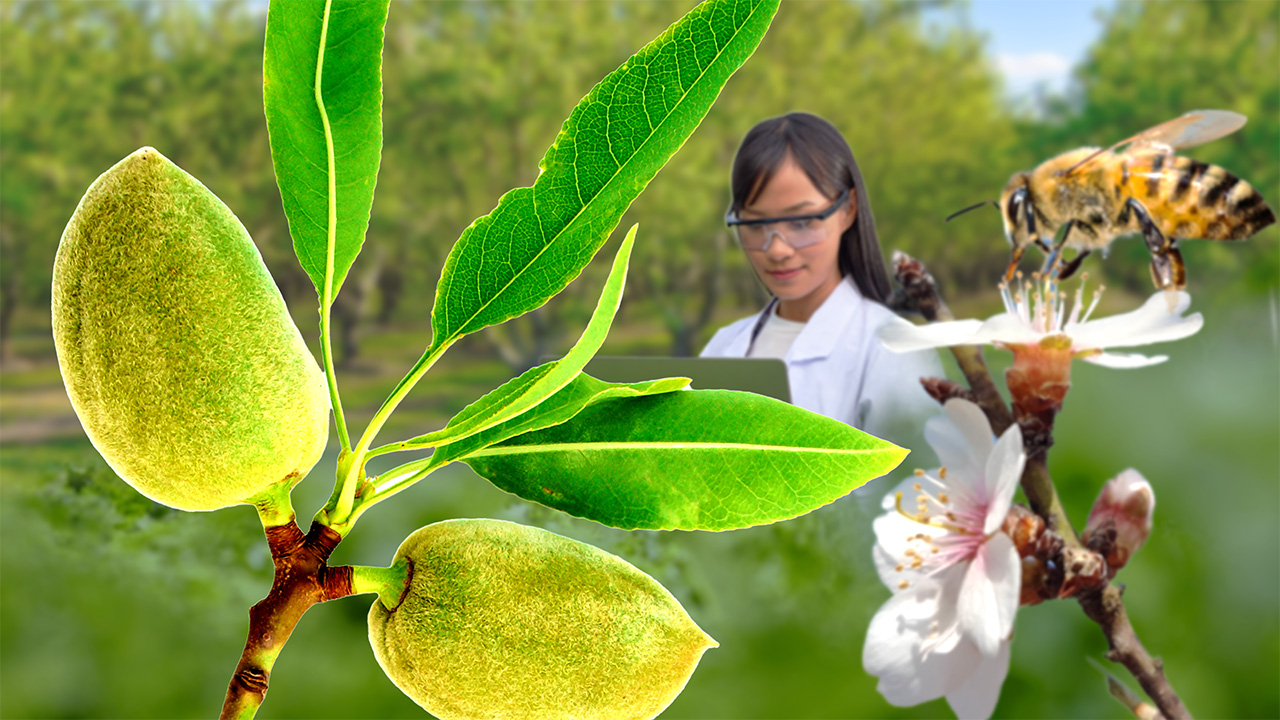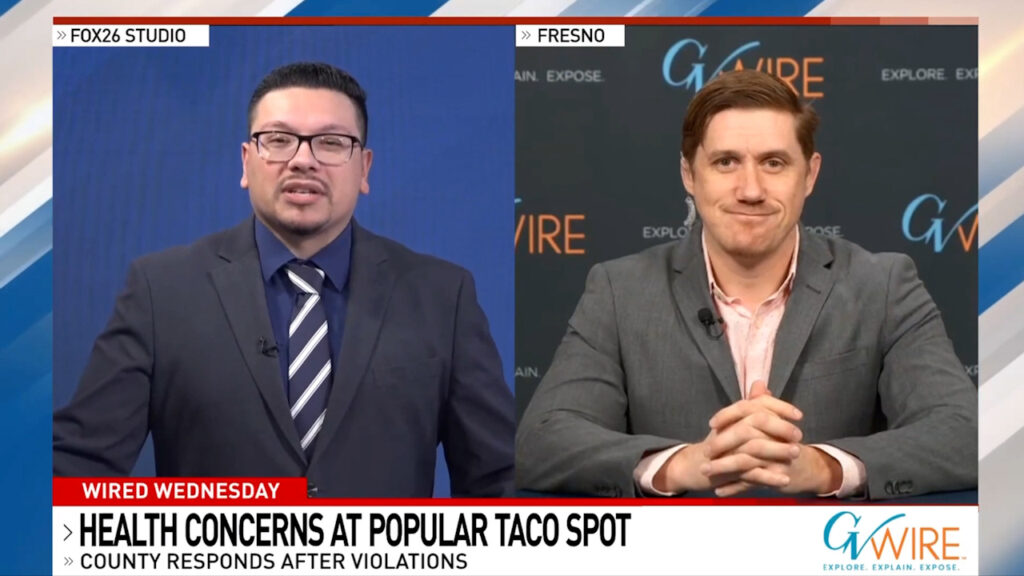Two California companies have developed self-pollinating almond trees, which could be a breakthrough for the most popular variety of the nut. (GV Wire Composite/David Rodriguez)

- Two companies have developed a type of nonpareil almond that can self-pollinate, with the first deliveries as early as 2027.
- Self-pollinating trees mean less dependence on bees for growers. It also means growers can dedicate more of their orchards to the most popular variety.
- The almond's cross-pollination requirement has helped it adapt to diverse and adverse environments.
Share
|
Getting your Trinity Audio player ready...
|
The nonpareil has nearly everything an almond grower wants. With a consistent color, sweet taste, and strong production, consumers love them just as marketers do.
The varietal typically generates upwards of 40% of all almond production in California, according to the Almond Board of California. But the nonpareil can be complicated to grow, said Thomas Gradziel, professor, geneticist, and plant breeder at UC Davis.
The tree rejects its own pollen, meaning it not only requires another pollinator tree to produce fruit from the blooms, but also requires bees to pollinate the trees. Growers have to dedicate as much as half the orchard to pollinizers.
It can be quite an investment, especially as securing bees during the all-important February months can be a headache for growers.
Two laboratories may have a solution — the world’s first self-pollinating nonpareil. Aptos-based Ohalo Genetics plans to have nursery trials for its FruitionOne this year and limited supplies by 2026, according to a news release from the company. Burchell Nursery will have town halls in February and March on details of its Nonpareil+.
“We saw this need in the almond market and began talking to almond nurseries and almond farmers about what their challenges were. We decided to roll up our sleeves and go to work to understand the genetic mechanisms that are at play,” said John Dombrosky, chief commercial officer for Ohalo. “Why are some almond trees able to self-pollinate and some aren’t?”
In 2023, California’s almond crop was worth $3.88 billion. The state produces 80% of the world’s supply and 100% of the U.S. supply.
That same year, Fresno County’s almond crop generated more than $1 billion in wholesale receipts, trailing only grapes in value.
Self-Pollination Will Help Farmers Feed the World: Dombrosky
Ohalo teamed with Yuba City-based Sierra Gold Nurseries to distribute the tree. With trees growing now, they plan to have a test plot by next year and take preorders by 2026 with deliveries in 2027.
Dombrosky describes the technique as speeding up the selective breeding process. While choosing the best characteristics for row crops can be done in decades, doing the same for trees can take generations or even centuries. Geneticists can speed up the process through gene editing and a breeding program that doesn’t rely on randomized traits from two parents, Dombrosky said.
“We were able to copy the way that other almond trees are able to self-pollinate without introducing any new or different DNA,” Dombrosky said. “You can kind of almost think of it as speed breeding.”

Ohalo did similar work on the potato, he said. Their adapted potato can be planted using seed stock rather than by propagation, making easier the ability to plant and harvest the world’s third-largest source of calories.
Global population could near 10 billion people by 2050, according to the United Nations. Feeding those people requires greater efficiencies, Dombrosky said. Dedicating as much as 50% of an orchard to trees with lower yields reduces those efficiencies.
“The FruitionOne almond planting system will be able to over time create this huge economic benefit for California almond growers to be able to have a self-fertilizing non-pareil almond and thus be able to almost double the efficiencies of the yield while reducing their environmental footprint,” Dombrosky said.
The Almond Board of California is watching for what this could mean for the industry.
“California almonds have a long history of continually improving farming techniques and have thrived for 170 years in part because of the industry’s ingenuity,” said Rick Kushman, manager of media relations for the organization. “We will be watching the outcome of Ohalo’s trial orchard plantings to see where they lead.”
Bee Mortality Rates Spike This Year: Gradziel
The nonpareil’s dependence on pollinizer trees can be a double-edged sword, Gradziel said.
The approximately 1 million almond acres in California require 2 million beehives.
“So basically, about 80% of all commercial beehives in the U.S. come to California to get that first crop,” Gradziel said.
Needing two-to-three hives, that can mean $600 an acre, Gradziel said. And at those high costs, many growers turn to self-fruitful varieties.
But beyond cost, bee populations can be very fragile. In 2006 and 2007, colony collapse disorder devastated hives. Some beekeepers reported losing 30% to 90% of their hives, according to the U.S. Environmental Protection Agency.
Beekeepers this year report similar losses, Gradziel said. And just as almond trees need bees, so do bees need almond trees.

“Beekeepers have seen upwards of 50% to 100% mortality,” Gradziel said. “The hives that are left over are weak. For those hives to be commercially profitable, they need to get them up to strength and the almond crop is what gets them up to strength.”
How many bees the trees will require remains to be seen, Dombrosky said. Growers will not need as many or they can use weaker colonies, he said.
Beyond pollination, having multiple tree varieties for pollinizers can be complicated.
Fungicides have to be applied at a very specific time, but that time varies on the varietal. Having a self-pollinating, or self-fruitful variety, means only spraying once. The same goes for harvesting. Shakers would only need to go out once.
Widespread adoption could bottleneck equipment availability, though, Gradziel said. With less need to vary an orchard, that means greater demand all at the same time.
Almond’s Pollination Traits Adapted it to ‘Austere’ Environments: Gradziel
Almonds have evolved to last in very austere environments, Gradziel said. Like Fresno, western Iran and Afghanistan have dry, hot summers, and mild winters. Only about 40% of a tree’s blooms will fruit, and that’s helped the plant conserve energy, especially if a frost or hail kills off blooms.
The almond’s out-crossing pollination method also helps it adapt to salty, dry, or adverse soils.
In the era of climate change, adaptability could be even more important.
“A lot of growers realize if we’re putting in an orchard now, this is the last time we’re really going to be managing this orchard in a traditional way,” Gradziel said.
The almond tree allows a lot of sunlight through because it’s so open. The tree’s open canopy also means less efficient water use.
Over dependence on a single variety could also make disease more rampant.
“If we had all nonpareil, it would make us very vulnerable to diseases,” Gradziel said. “If a new disease came in that was very, very damaging to nonpareil, the industry doesn’t have a buffer. That said, we’ve had a hundred years where nonpareils have been 50% of the crop and we haven’t seen this type of threat coming in, either disease or insects.”
Ohalo Wants Growers to Be First to Test Self-Pollinating Variety
It’s not the first time scientists have created a self-pollinating almond variety. The state’s third-most grown varietal, the Independence, also doesn’t require pollinator trees. As with many new varieties, growers were hesitant of the tree created in 2008, said Mark Turmon, managing partner of Sierra Valley Almonds.
“It takes a while for people to figure out, ‘what’s this variety? What does it do? How does it taste? What does it look like?’ ” Torman said.
But now, it’s the third-most produced nut. Many consumers prefer the nonpareil’s taste, Turmon said, but the Independence sells well in India.
New varieties only spend a handful of years in testing, but farmers invest expecting almond trees to last 25 years. The nonpareil often lasts that long. But finding out how a tree behaves 15 or 20 years into its lifecycle takes that much research time.
“I don’t think the nurseries do enough long-term testing,” Turmon said. “I’m talking maybe 10 years. An almond will take three to four to five years to come into full production.”
Dombrosky doesn’t expect widespread adoption of the self-pollinating variety to occur quickly, but they’re confident in their tree. Being nonpareil clones means they know how it’ll taste and produce, Dombrosky said.
And the adaptations don’t stop with the first generation. They’ll be looking at water, nitrogen, and other environmental stress efficiencies, he said.
The first round of buyers will be those growers looking to try something new, Dombrosky said.
“You plant an almond tree, you yield it for 20 years. So, we’re taking a very long-run view of this,” Dombrosky said. “I think this FruitionOne first generation almond tree is going to be just fantastic for five, six, seven, eight years. And while we’re seeing and gathering data back from the marketplace, we’ll be working actively just like we were three or fours years ago on what the next better iteration can be.”
RELATED TOPICS:
Categories

Dan Bongino to Step Down From FBI

Judge Allows Trump’s Ballroom Project to Proceed for Now

Canva Down for Thousands, Downdetector Reports
















